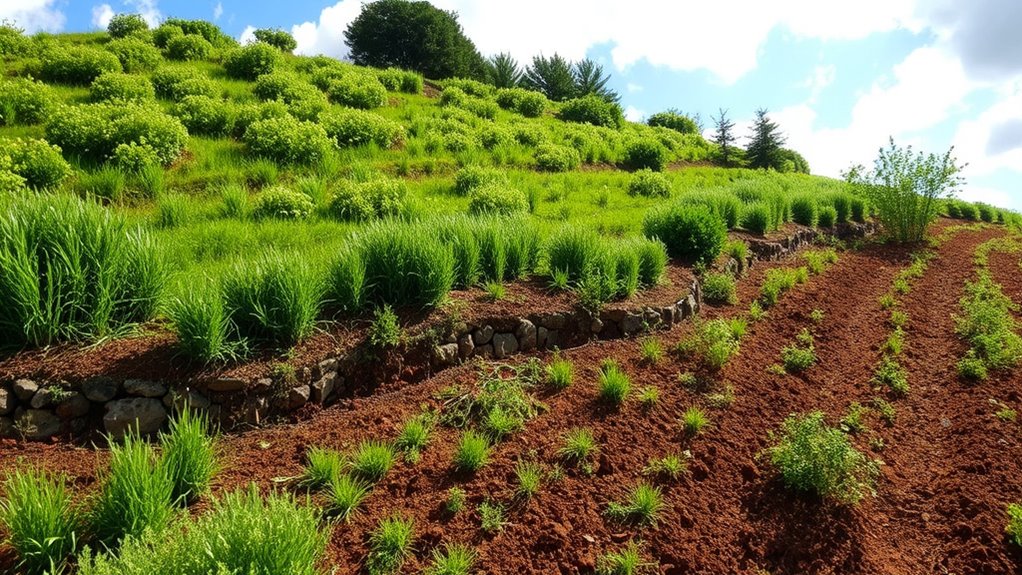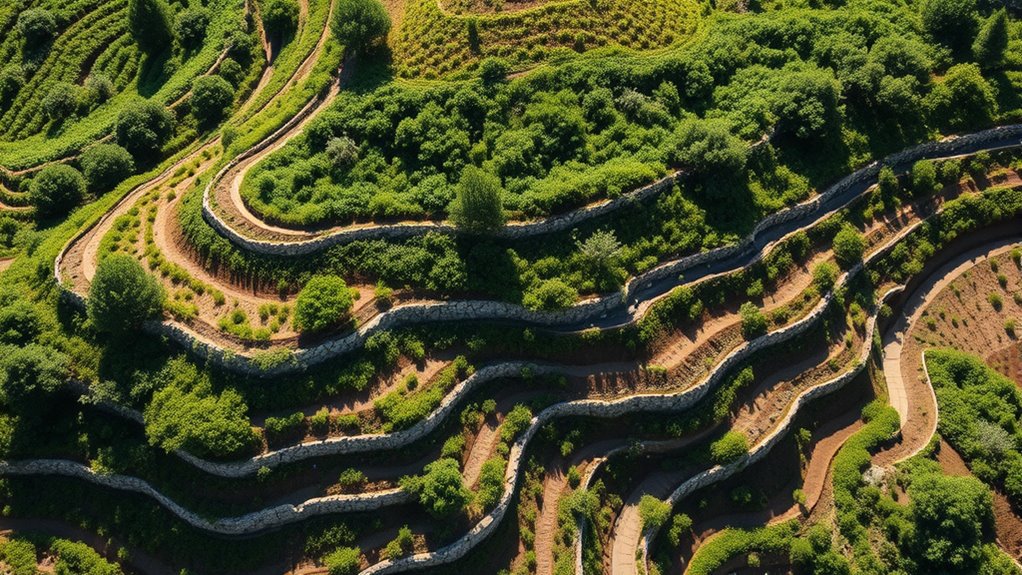To prevent soil erosion and runoff on your land, start by using cover crops like clover or rye to protect the soil and anchor roots. Implement contour farming along natural land slopes to slow water flow and improve absorption. Consider mulching or installing silt fences for extra protection, and maintain healthy, organic-rich soil through testing and proper management. By adopting these practices, you’ll preserve land productivity and water quality—more effective strategies can help you achieve long-term erosion control.
Key Takeaways
- Implement cover crops like clover, vetch, or rye to protect soil and reduce runoff during off-season periods.
- Use contour farming to plow or plant along land contours, slowing water flow and preventing erosion.
- Apply mulching and install silt fences to provide additional barriers against soil movement and runoff.
- Regularly test soil to optimize nutrient management and maintain soil health for better erosion resistance.
- Incorporate long-term practices such as proper drainage, organic matter buildup, and minimizing tillage for sustainable land protection.

Soil erosion and runoff pose serious threats to land productivity and water quality, especially during heavy rains or improper land management. When water flows over bare soil, it can carry away valuable topsoil, reducing your land’s fertility and increasing sedimentation in nearby water bodies. Luckily, you can take effective steps to prevent this. One of the best methods is planting cover crops. These plants, such as clover, vetch, or rye, grow during off-season periods or between main crops, forming a protective layer over the soil. Cover crops help anchor the soil with their roots, absorb excess water, and reduce the speed of runoff. They also improve soil structure over time, making it more resistant to erosion. By maintaining a cover throughout the year, you minimize the chances of soil being washed away during storms. Additionally, soil testing can help determine the specific nutrient needs and optimal crop choices to enhance soil health and stability. Incorporating erosion control methods like mulching or installing silt fences can further safeguard your land from degradation. Using modern land management techniques can also contribute significantly to erosion prevention efforts. Proper land management practices, such as maintaining healthy soil organic matter, play a vital role in overall soil stability.
Another powerful technique you should consider is contour farming. This involves plowing or planting along the natural contours of your land, following the shape of the terrain rather than going straight up and down slopes. Contour farming slows down water flow, allowing it to infiltrate the soil rather than rushing downhill, where it can carry away topsoil. When combined with cover crops, contour farming creates a highly effective erosion control system. The contour lines act as natural barriers, reducing runoff velocity, while the cover crops stabilize the soil surface. This integrated approach preserves your land’s productivity and prevents the formation of gullies or rills that can worsen erosion over time. Properly implementing these methods can lead to increased water retention and healthier soil over the long term. Additionally, selecting appropriate crop varieties suited for erosion-prone areas can further enhance stability.
Implementing these practices requires some planning, but the long-term benefits are well worth it. You’ll notice improved water retention, healthier soil, and fewer issues with sedimentation or nutrient loss. Additionally, using cover crops can also provide additional benefits like weed suppression and organic matter buildup, further enhancing your soil’s resilience. Managing runoff effectively also involves maintaining proper drainage systems and avoiding over-tillage, which can disturb soil structure. Remember, the key is to work with the land’s natural features, applying techniques like contour farming, and to keep the soil covered with vegetation whenever possible. Emphasizing soil conservation practices ensures the sustainability of your land for years to come.
Frequently Asked Questions
How Do Climate Changes Influence Soil Erosion Risks?
Climate changes increase soil erosion risks by causing more intense storms and unpredictable rainfall, which you need to contemplate in your erosion modeling. To adapt, you should implement climate adaptation strategies like planting cover crops and building terraces. These measures help stabilize soil and reduce runoff. Staying updated with erosion modeling tools allows you to predict and manage erosion more effectively, ensuring your land remains resilient despite changing climate conditions.
Can Native Plants Effectively Prevent Runoff on Steep Slopes?
Native plants can effectively prevent runoff on steep slopes because they have deep roots that stabilize the soil. Their dense foliage slows water flow, reducing erosion and runoff. When you plant native species, you create a natural barrier that absorbs rainwater and minimizes surface runoff. This eco-friendly approach not only prevents soil loss but also supports local ecosystems, making your land more resilient to weather changes and erosion risks.
What Are Cost-Effective Erosion Control Methods for Small Farms?
Imagine your farm as a shield protecting valuable soil. To strengthen it cost-effectively, you should plant cover crops that act like a natural armor, holding soil in place. Mulching techniques further reinforce this barrier by reducing runoff and evaporation. These methods are affordable, easy to implement, and improve your land’s resilience. Using cover crops and mulching creates a sturdy shield that keeps your soil safe without breaking the bank.
How Does Soil Type Affect Erosion Control Strategies?
Soil type greatly influences your erosion mitigation strategies. For instance, sandy soils drain quickly but are prone to erosion, so you might add organic matter or plant cover crops to stabilize it. Clay soils hold moisture but can compact easily, requiring aeration and contour planting. Understanding your soil composition helps you choose cost-effective methods, ensuring you tailor erosion control techniques that work best for your land’s specific needs.
Are There Legal Regulations for Land Erosion Management?
You need to check your local regulations because land use policies often require erosion control permits before starting projects. These rules help guarantee proper management of soil erosion and runoff, protecting the environment. You’re responsible for following permits and guidelines, which may include implementing specific erosion prevention measures. Failing to comply could lead to fines or penalties, so always stay informed about the legal requirements for land erosion management in your area.
Conclusion
Now that you understand the importance of preventing soil erosion and runoff, the real challenge begins. Will your efforts be enough to protect your land from the relentless forces of nature? Every action you take—planting cover crops, building terraces, or installing barriers—brings you closer to safeguarding your soil. But remember, the battle isn’t over yet. The future of your land hinges on what you do next—are you ready to face what’s coming?










